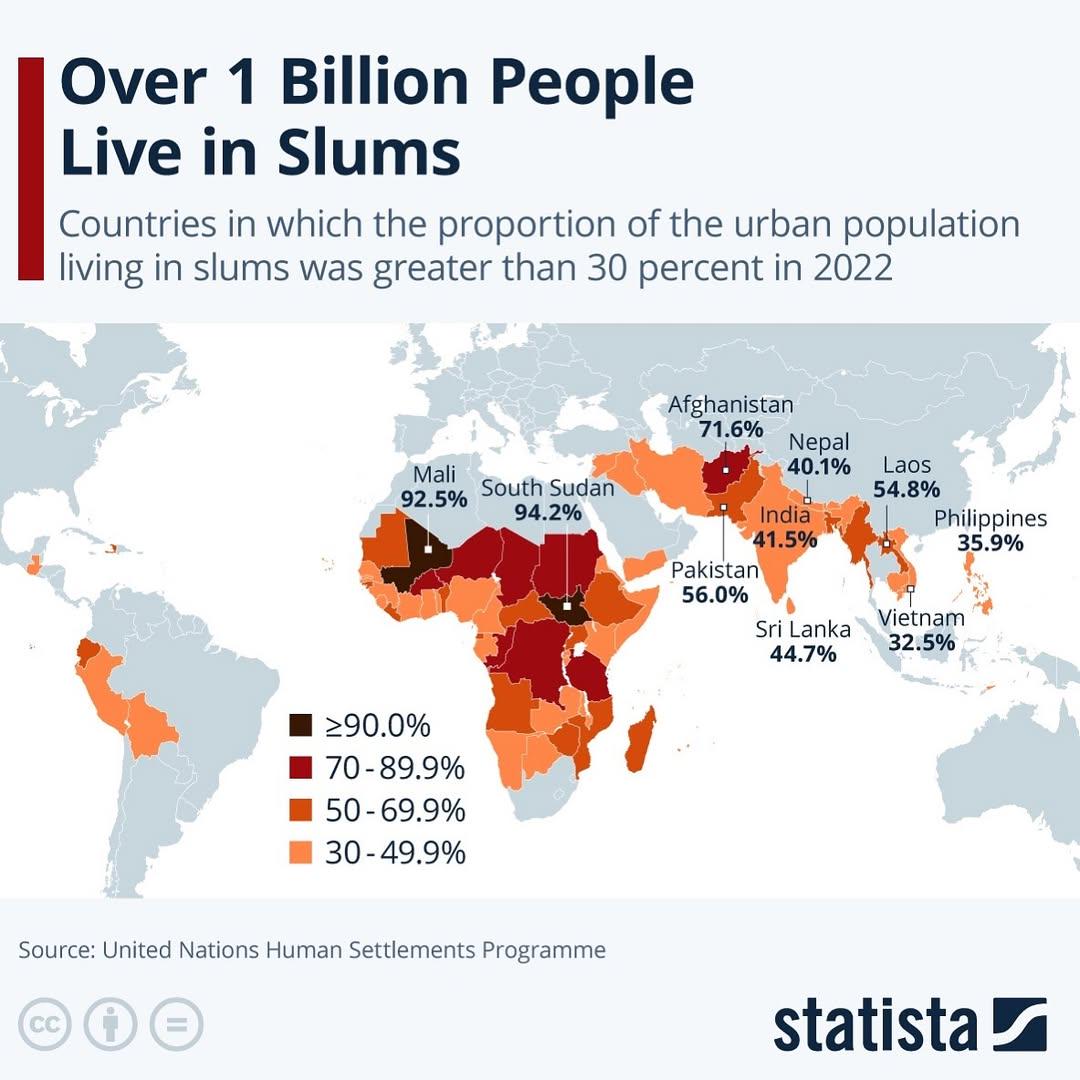Slum Population Distribution Map


Alex Cartwright
Senior Cartographer & GIS Specialist
Alex Cartwright is a renowned cartographer and geographic information systems specialist with over 15 years of experience in spatial analysis and data...
Geographic Analysis
What This Map Shows
The map titled "Over 1 billion people live in slums" provides a stark visual representation of the global distribution of slum populations. It highlights the regions where informal settlements thrive and shows the staggering number of individuals living in these conditions. Slums, often characterized by inadequate housing, lack of sanitation, and insufficient access to basic services, are a critical topic in urban geography and social studies. This visualization serves as a starting point for understanding the complexities of urbanization and the challenges faced by millions around the world.
Deep Dive into Slum Populations
Slums are not just places of poverty; they are also dynamic urban environments that reflect the intersection of rapid urbanization, economic disparity, and social issues. According to the UN-Habitat, over 1 billion people—approximately one in every eight people on Earth—live in slums. This figure underscores the magnitude of the issue, but what does it really mean?
Slum populations are typically found in developing countries where urban migration is rampant. People move to cities in search of better employment opportunities, but often they find themselves in informal settlements due to the shortage of affordable housing. These settlements can grow rapidly, resulting in overcrowded living conditions. In many cases, slums are situated on land that is not legally owned or designated for housing, making residents vulnerable to eviction and displacement.
Interestingly, slums can vary significantly from one region to another. For instance, in India, slums like Dharavi in Mumbai are bustling economic hubs with a rich tapestry of small-scale industries, while in parts of sub-Saharan Africa, slums may be characterized by extreme poverty and limited access to services. This diversity reflects the unique socio-economic contexts of different regions and highlights the need for tailored approaches to urban development.
The challenges faced by slum dwellers are multifaceted. Access to clean water, sanitation, and healthcare is often severely limited, leading to public health crises. Moreover, education opportunities are scarce, perpetuating the cycle of poverty. According to a report by the World Bank, slum dwellers frequently lack the political voice to advocate for their needs, which further exacerbates their situation.
Regional Analysis
When analyzing the distribution of slum populations, it's crucial to consider regional differences. For instance, in South Asia, particularly in India and Bangladesh, rapid urbanization has led to a significant increase in slum populations. Cities like Dhaka and Mumbai are home to millions living in informal settlements, where the challenges of overcrowding and inadequate infrastructure are pronounced.
In contrast, Latin America presents a different picture. While slums, known as favelas in Brazil, are prevalent in cities like Rio de Janeiro, these areas often have stronger community networks and more informal economies. Interestingly, some favelas have developed vibrant cultural identities and have even become key tourist attractions, highlighting a complex relationship between poverty and community resilience.
Sub-Saharan Africa also shows alarming statistics, with cities like Lagos and Nairobi witnessing rapid urban growth. The United Nations projects that by 2050, the urban population in Africa will nearly double, leading to even more slum formation if proper urban planning and policies are not implemented.
Significance and Impact
Understanding slum populations is crucial for several reasons. First, it sheds light on urban inequality and the pressing need for sustainable urban development policies. As cities expand, planners and policymakers must address the needs of all residents, not just those in formal housing.
Moreover, the implications extend beyond just housing. The health crises that can arise in slum areas—such as outbreaks of diseases like cholera or COVID-19—can have far-reaching effects on public health systems and economies. Urban planning that incorporates slum upgrading, improved infrastructure, and access to basic services is essential for fostering healthier, more equitable communities.
Looking ahead, the trends are concerning. The UN estimates that if current trajectories continue, the number of people living in slums could rise significantly. However, innovative approaches to urban planning, like participatory governance and community-led development, offer hope for reversing this trend. Have you noticed how some cities are beginning to invest in upgrading slum areas instead of demolishing them? This shift in perspective could be pivotal in improving the lives of billions.
In conclusion, the map showing that over 1 billion people live in slums is more than just a visualization; it represents a call to action. Understanding the dynamics of slum populations is essential for creating a more equitable and sustainable urban future for all.
Visualization Details
- Published
- October 15, 2025
- Views
- 8
Comments
Loading comments...